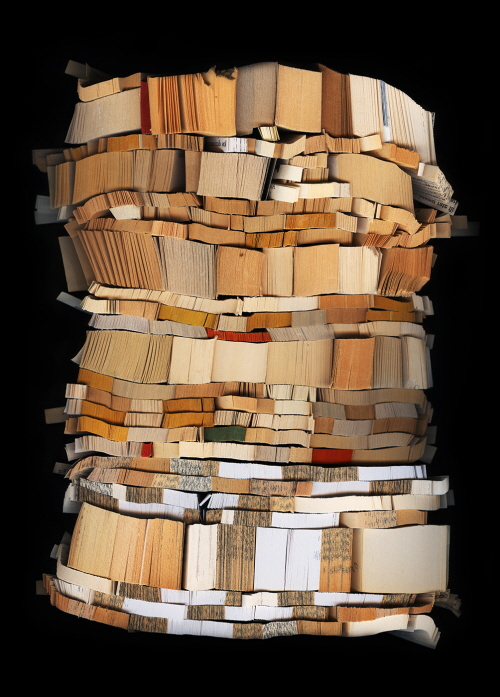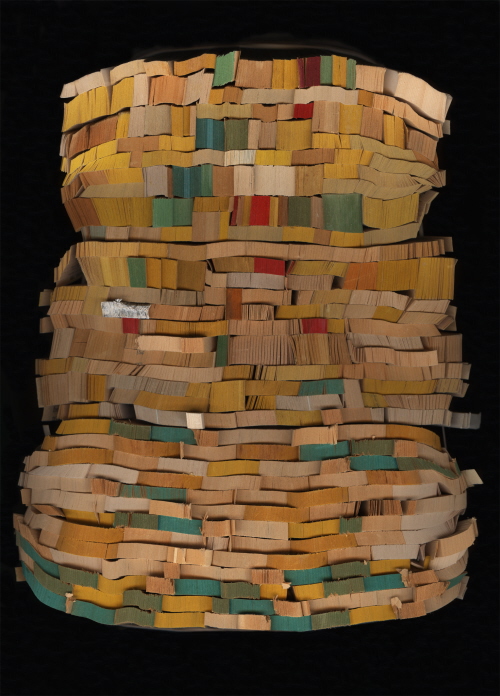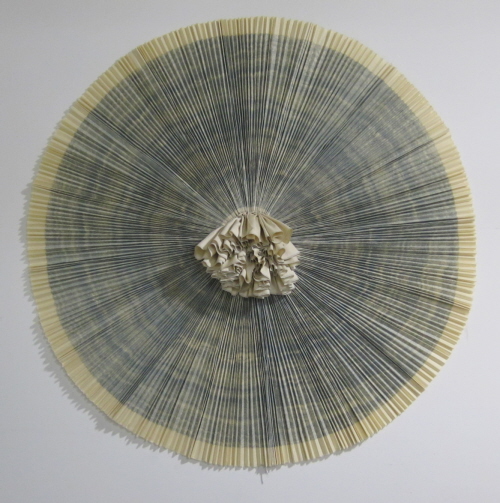
Ann Hamilton, “ciliary #3,” 2010. Lithograph, fabric, bamboo and hardwood dowel construction. Approx. diameter: 58" (147.3 cm). Variable edition of 19 unique works, published by Gemini G.E.L., Los Angeles and New York. "ciliary" © 2010 Ann Hamilton and Gemini G.E.L. LLC.
Ann Hamilton’s work is founded on the idea of the line – both in its material form as thread, fiber, and hair; and its conceptual form in written and drawn communication. From this deceptively simple beginning point, she creates subtle and profound worlds and objects that stretch our understanding of contemporary life in a technological age and touch upon the deepest reaches of what it means to be human – in particular, our ability to relate to others, build meaningful relationships, and share ideas through communication. This path of inquiry began over three decades ago from her first love of textiles, then expanded into sophisticated and revelatory installation/performance works, a number of which can be reviewed on the artist’s website. Though she has ventured into increasingly conceptual territory over the years, Hamilton has never lost sight of her beginnings in material culture and the rich presence of the hand-made object. Her work first seduces with its visual and tactile appeal, and then reveals its conceptual underpinnings.
An online interview with Art21 raises the dilemma of ephemerality for Hamilton’s work – the fact that it must be experienced in a particular time and place. This issue is endemic to artists who work in site-specific installation, and it often becomes increasingly problematic as time passes. Though Hamilton has created objects throughout her career, the early examples do not fully stand on their own. Some, such as the body object series of 1984-93, were “performed” and documented with photography (the images were then editioned and published); others are sculptural objects or digital media that played a role in an installation at one time. However, as noted by scholar Joan Simon in her 2008 essay on Hamilton’s editions for Gemini G.E.L., she has recently “turned to different sorts of makings. At one end of the spectrum are … chants and song; at the other reach of the spectrum are the objects that bespeak individually and as ensembles.” (Ann Hamilton at Gemini [exh.cat.], Gemini G.E.L. at Joni Moisant Weyl, New York, 2008, 15). The human voice has certainly played a greater role in Hamilton’s recent work, but she has also created objects and architectural structures that are self-contained and have a material presence, including a number of prints and variable editions. This new direction in her work partially satisfies, as it has for many artists, an interest in reaching a wider audience and also presents new challenges and avenues of exploration.

Ann Hamilton. “Legend,” 2007. Lithography on gampi tissue collaged and mounted by the artist onto cotton. Variable edition of 8 unique works. Sizes vary, approximately 7' x 8 ' (2.13 x 2.44 m). Published by Gemini G.E.L., Los Angeles and New York. legend © 2007 Ann Hamilton and Gemini G.E.L. LLC.
Hamilton first entered a printmaking studio to create original prints in 2000 at Gemini G.E.L. in Los Angeles. In a recent email interview with the author, Hamilton described her intention in this initial visit: “I was …curious to find a process that would link my first hand – which is a cloth hand – with the many possibilities of paper and ink and form.” The result was a blind-embossed diptych: written, and wreathe, characterized by a cloth-like surface that evokes a number of associations: Braille, running water, glacial movements. She has since returned a number of times, creating a new body of work with each visit (examples through 2007 can be viewed on the Gemini G.E.L. online catalogue raisonné hosted by the National Gallery of Art). As a whole, the work is playful and exploratory, and relates to her work in other mediums, including photographic imagery, sculptural multiples, sound-based work, and manipulation of fibers.
After a decade of experimentation with the potential of printmaking in her work, Hamilton’s recent endeavors reveal a new level of comfort and mastery with this alternative means of expression and build on ideas that have been percolating for a number of years in the artist’s mind. In addition, the story behind each edition underscores the fact that printmaking has become an integrated aspect of her artistic thought.

Ann Hamilton. “book weight bb (human carriage),” 2009. Archival inkjet print. Image: 58 ½ x 42 inches; sheet: 60 ½ x 44 inches. Edition of 10, published by Carl Solway Gallery, Cincinnati. Image courtesy Carl Solway Gallery, Cincinnati.
Hamilton’s book weights (human carriage) series, 2009 (Carl Solway Gallery, Cincinnati), grew out of the artist’s site-specific installation titled human carriage, commissioned for the exhibition The Third Mind: American Artists Contemplate Asia, 1860-1989 at the Solomon R. Guggenheim Museum, January 30 – April 19, 2009. In response to the thesis of the exhibition, Hamilton formulated a question that guided the development of the project: “how does one account for the path of relations and connections made by a reader (who is already a storehouse of everything he/she has ever read) that is changed when the reader meets a new book arriving from afar?” (Ann Hamilton in Ann Hamilton: “book weights (human carriage)” Editions [exh.cat.], Carl Solway Gallery, Cincinnati, 2010, 56). The resulting installation used the spiraling walls of Frank Lloyd Wright’s central rotunda as support for a ramp down which two Tibetan prayer bells traveled, chiming as they descended. Their perpetual motion was made possible by counterbalancing weights comprised of books that had been cross-sectioned into strips by a guillotine paper cutter and then glued together. The reconfigured books catapulted the bells to the top of the ramp at the end of each cycle. As they prepared to ship the components of the installation for the exhibition, Hamilton and her assistants scanned each of the book weights as a means of taking inventory of the work. In the process, Hamilton realized these digital files had a beauty of their own and decided to explore their unique qualities as self-contained images. The files were enlarged to fill an expanse of several feet and printed with archival inks in small editions. Each of the book weights – which represent a unique configuration of words, colors, and textures – becomes monumental through this treatment and takes on a physical presence that is almost anthropomorphic. The series is a poetic visualization of the artist’s guiding principle for the project: the individual as a storehouse of knowledge transmitted through text.

Ann Hamilton. “book weight ww (human carriage),” 2009. Archival inkjet print. Image: 36 x 25 ¾ inches; sheet: 44 x 34 inches. Edition of 10, published by Carl Solway Gallery, Cincinnati. Image courtesy Carl Solway Gallery, Cincinnati.
The ciliary series, 2010, is a culmination of Hamilton’s decade-long collaborative relationship with Gemini G.E.L. and mark a new level of achievement in her work with printmaking. With a diameter of nearly five feet, the ciliary are wall-mounted objects of a human scale that yet lend a sense of quiet magnitude to the space they occupy. Comprised of accordion-folded lithographs that compress bands of meandering lines of varying intensity, each is punctuated by a burst of fabric in a coordinating color at the center. A variable edition of 19, each is a different hue, ranging the spectrum from vivid to subtle (i.e. tangerine orange, hot pink and lime green on one end; pea green, deep burgundy and gossamer silver on the other). The initial impression varies immensely depending on the color variant at hand. The form is at once familiar and mysterious, bringing to mind numerous associations, both natural and man-made: the cross-section of an immense tree, a dancer’s unfurled skirt, a folded fan, an eye, a Seventeenth-Century Dutch collar, a well. These referents spring naturally from the circular structure – a response Hamilton purposefully elicits from the viewer, born of her meditations on the timelessness of this shape and its symbolism across time and cultures.

Ann Hamilton, “ciliary #11,” 2010. Lithograph, fabric, bamboo and hardwood dowel construction. Approx. diameter: 58" (147.3 cm). Variable edition of 19 unique works, published by Gemini G.E.L., Los Angeles and New York. "ciliary" © 2010 Ann Hamilton and Gemini G.E.L. LLC.
In a recent email interview with the author, Hamilton commented on how the various elements of this project came together. The primary element – a lithographic plate – was created during her initial visit in 2000. It began with the simple act of drawing a line – the first followed by others built on top of it, resulting in a “geologic band [that]…contains all the attentions of its moment of making – breath and body in coordination – it is a primary act of bodily projection…they accumulate and amplify as they fill the plate.” Yet Hamilton was not satisfied with the image as a “flat field” and set the plate aside. Later, as she worked on her first permanent installation – a cylindrical performance space based on the double-helix, titled the tower – her thoughts centered around Ralph Waldo Emerson’s 1841 essay “Circles,” a meditation on the form’s associations with the natural and metaphysical worlds. At the same time, she was working on a project in Laos (meditation boat, 2009) and was struck by the bountiful presence of fabric in the marketplace and the intricately pleated traditional skirts worn by the women of the hill cultures. In Hamilton’s words, “when … laid flat they become – the most extraordinary circles.”
All of these elements came together in the production of the ciliary series, an experience she says “helped anchor me in a process closer to the lap and the hand” while she worked on the aforementioned building projects that were more concept-driven. The banded lithography plate created a decade earlier was brought out and printed in various colors on Mitsumata paper, a Japanese fiber that has a soft, cloth-like appearance and feel. For each ciliary, eight prints in one color are folded in pleats and joined at the center to create a circle, to which is sewn a swath of fabric in a coordinating color. The structure is reinforced with bamboo, dowels, and a wooden circular cleat at the center.
The completed form brought forward Hamilton’s study of Emerson’s essay, particularly the opening lines, “The eye is the first circle; the horizon which it forms is the second; and throughout nature this primary picture is repeated without end. It is the highest emblem in the cipher of the world.” Thus, the title ciliary (the adjectival form of cilia), a term that references the eye as well as the mystery of biological processes, and hence, life.
Though it is not possible to be fully aware of all of Hamilton’s ideas and influences when seeing the book weights (human carriage) and ciliary works on their own, their intense material presence lend a stunning impression and suggest a universal truth that demands further understanding. These qualities have always been apparent in her installation and site-specific work, but she has now brought the same level of power and suggestion to her original editions. Both series reflect the maturity and finesse of a master artist who has achieved full fluidity with her materials and the means of communicating her ideas. As object-based work becomes a greater component of Hamilton’s artistic practice, her mastery of this medium promises a body of stunning and influential work that will likely have a significant impact on the future of printmaking.



